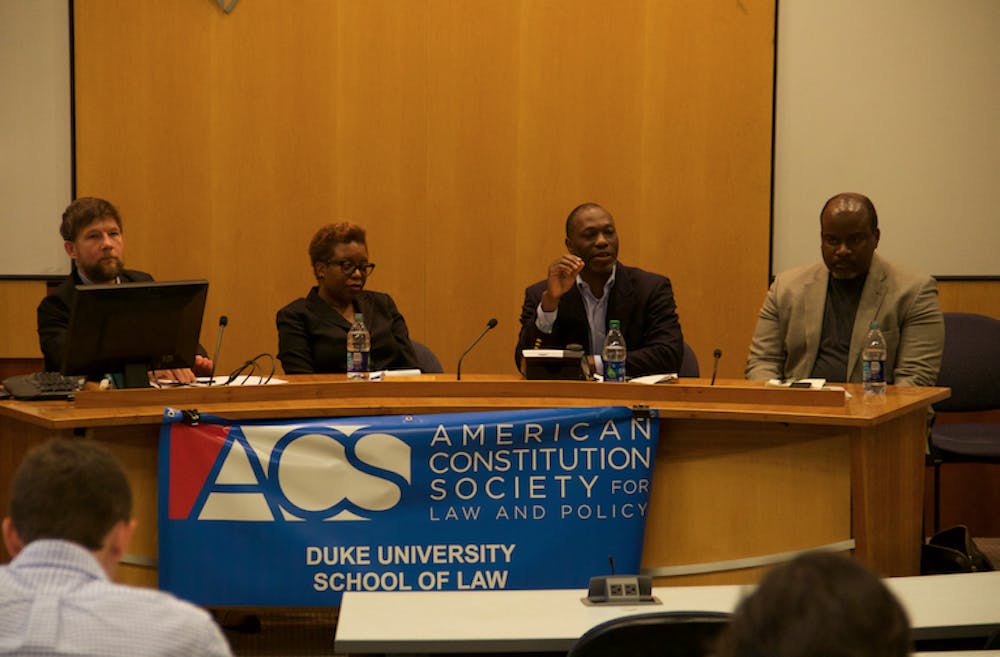Dealing with racial gerrymandering is one of the thorniest legal issues the Supreme Court has to tackle, agreed several scholars at a Wednesday panel discussion.
Sponsored by the American Constitution Society, the event at the Duke Law School discussed why gerrymandering persists as well as how race factors into the equation. Gerrymandering is the practice of manipulating district boundaries to give certain political candidates an advantage, a process that sometimes involves packing racial groups into certain districts.
Jedediah Purdy, Robinson O. Everett professor of law, moderated the panel discussion. He first asked the panelists what makes drawing electoral district lines so challenging.
Guy-Uriel Charles, Charles S. Rhyne professor of law and one of the panelists, attributed the phenomenon to partisan and “self-interested individuals." They often try to redraw district lines in a way that will increase their political power, he said.
“You have a decentralized framework, ambiguous legal rules and a process that is being designed by self-interested parties as opposed to experts," Charles said. "There is a strong relationship between partisanship or ideology and different types of identities, and at the heart of it all is the quest or search for political power. That's the landscape as to what makes this process fairly complicated."
Marcia Johnson-Blanco—a panelist and the co-director of the voting rights project for the Lawyers' Committee for Civil Rights Under Law—agreed. She said that the redistricting process, when done improperly, can interfere with the typical principles of representative democracy.
“It's a political process that comes into tension with ensuring that voters have the opportunity to elect their candidates of choice, particularly in the context of minority voters,” Johnson-Blanco said. “Are voters allowed to elect their candidates of choice or are politicians drawing the lines such that they basically guarantee the outcomes of the elections?'”
Atiba Ellis, a professor of law at West Virginia University and the third panelist, also touched on how gerrymandering has been historically tied to race. Johnson-Blanco said that minorities are particularly vulnerable to gerrymandering after the 2013 Supreme Court decision in Shelby County v. Holder, which struck down parts of the Voting Rights Act.
In that case, the Supreme Court ruled unconstitutional a section of the VRA which specified nine states, also known as "covered states," that had to get federal pre-clearance before changing voting laws. The ruling did leave open the possibility for Congress to enact new rules on who would be subject to pre-clearance and also left non-discrimination provisions intact.
McCrory v. Harris
One North Carolina racial gerrymandering case is currently being heard at the Supreme Court—McCrory v. Harris, referring to former Republican Governor Pat McCrory.
The case handles a dispute about racial gerrymandering in congressional districts one and 12. The plaintiffs argue that North Carolina improperly used race in redistricting to weaken minority voting power in other districts, violating the Equal Protection Clause of the Constitution.
But North Carolina has a different interpretation. With regards to district 12, they are arguing that any gerrymandering was done purely on political, not racial, grounds.
And in regards to district one, North Carolina is arguing that their use of race was actually done to comply with the VRA in the first place. The VRA—as it would have applied to North Carolina in 2011—required redistricting plans to not prevent minority group members from being able to enact their preferred candidate of choice. North Carolina contends that creating a majority-minority district was their way of ensuring this.
North Carolina and other states have claimed this tension between the VRA and the Constitution puts them in a classic "rock and a hard place" situation.
Charles touched on this dilemma as well, saying there is a limit on how much consideration of race is too much. It might be necessary to some extent but also could be misused by both political parties on different occasions, he noted.
“So, the bottom line there is that we have to be aware and conscious of race," he said. "But you can't be aware and conscious of race too much because there are times in which the line drawer also wants to undermine racial representation either because of animus or for partisan advantage."
Due to this difficult tension, Charles said he believes that the Supreme Court is moving in the direction of making race considerations unconstitutional as a whole. He noted that both Justices Samuel Alito and Clarence Thomas have said that considering race in the electoral process at all is inconsistent with the greater “race jurisprudence."
“From my perspective, the writing's on the wall,” he said.
Get The Chronicle straight to your inbox
Signup for our weekly newsletter. Cancel at any time.
Class of 2019
Editor-in-chief 2017-18,
Local and national news department head 2016-17
Born in Hyderabad, India, Likhitha Butchireddygari moved to Baltimore at a young age. She is pursuing a Program II major entitled "Digital Democracy and Data" about the future of the American democracy.

